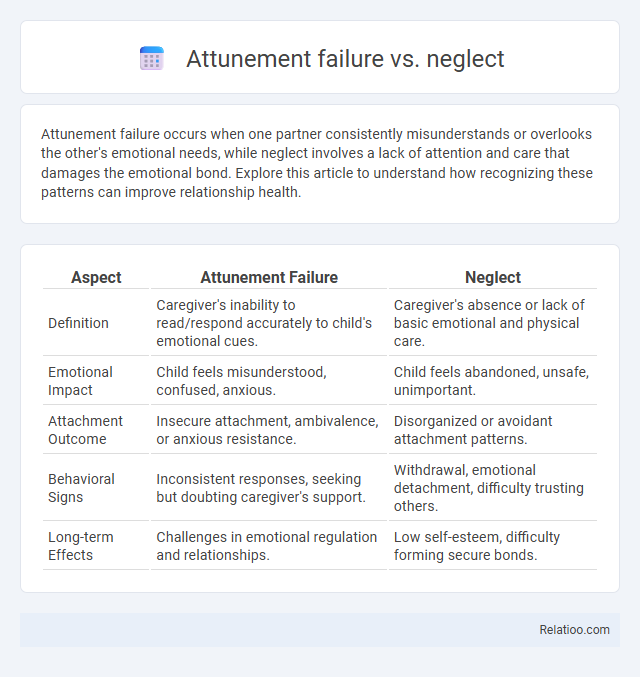Attunement failure occurs when one partner consistently misunderstands or overlooks the other's emotional needs, while neglect involves a lack of attention and care that damages the emotional bond. Explore this article to understand how recognizing these patterns can improve relationship health.
Table of Comparison
| Aspect | Attunement Failure | Neglect |
|---|---|---|
| Definition | Caregiver's inability to read/respond accurately to child's emotional cues. | Caregiver's absence or lack of basic emotional and physical care. |
| Emotional Impact | Child feels misunderstood, confused, anxious. | Child feels abandoned, unsafe, unimportant. |
| Attachment Outcome | Insecure attachment, ambivalence, or anxious resistance. | Disorganized or avoidant attachment patterns. |
| Behavioral Signs | Inconsistent responses, seeking but doubting caregiver's support. | Withdrawal, emotional detachment, difficulty trusting others. |
| Long-term Effects | Challenges in emotional regulation and relationships. | Low self-esteem, difficulty forming secure bonds. |
Understanding Attunement Failure: Definition and Impact
Understanding attunement failure involves recognizing a caregiver's inability to accurately perceive and respond to Your emotional cues, which can disrupt secure attachment development. Neglect, a more severe form of emotional unavailability, entails consistent lack of responsiveness to a child's needs, often leading to long-term psychological effects. Both attunement failure and neglect significantly impact a child's emotional regulation and interpersonal relationships but differ in degree and patterns of interaction disruption.
What Constitutes Neglect in Child Development
Neglect in child development constitutes the consistent failure to meet a child's basic physical, emotional, educational, or medical needs, leading to significant harm or risk of harm. Unlike occasional attunement failures, which involve temporary lapses in caregiver responsiveness to a child's emotional cues, neglect entails persistent disregard or omission of necessary care that impairs a child's growth and well-being. Understanding these distinctions helps you identify and address the critical factors that contribute to healthy developmental outcomes.
Attunement Failure vs Neglect: Key Differences
Attunement failure involves a caregiver's inability to accurately perceive and respond to a child's emotional needs, whereas neglect refers to the broader lack of providing essential physical and emotional care. Attunement failure specifically disrupts emotional connection and communication between caregiver and child, while neglect encompasses both emotional and physical deprivation that can lead to more severe developmental consequences. Understanding these key differences highlights the importance of emotional responsiveness in attunement versus the overall caregiving deficiencies seen in neglect.
Emotional Consequences of Attunement Failure
Attunement failure leads to emotional consequences such as feelings of disconnection, insecurity, and impaired self-regulation, often resulting in anxiety and difficulties in forming trusting relationships. Neglect, a more severe form of emotional unavailability, exacerbates these issues by fostering deep-rooted emotional trauma, withdrawal, and attachment disorders. Understanding the nuanced impacts of attunement failure highlights its crucial role in emotional development and the prevention of long-term psychological distress.
Psychological and Physical Effects of Neglect
Neglect, distinct from attunement failure, leads to profound psychological effects such as attachment disorders, chronic anxiety, and impaired emotional regulation, while physical effects include developmental delays, weakened immune response, and increased risk of chronic illnesses. Attunement failure involves a caregiver's inconsistent emotional responsiveness, which primarily disrupts emotional bonding and self-regulation skills but may not lead to the severe physical consequences seen in neglect. Understanding these differences highlights neglect's critical impact on both mental health and physiological development, emphasizing the necessity for early intervention and supportive caregiving environments.
Signs and Symptoms of Attunement Failure in Children
Signs and symptoms of attunement failure in children include difficulty regulating emotions, withdrawal from social interactions, and inconsistent responses to caregivers' cues. Neglect often presents with similar emotional and developmental delays but is characterized by a lack of consistent care and stimulation, leading to attachment issues. You can observe these differences by noting how a child's emotional responses align with their caregiver's sensitivity and availability.
Recognizing Neglect: Warning Indicators
Neglect is identified by prolonged deprivation of basic emotional and physical needs, while attunement failure involves inconsistent or inaccurate emotional response by caregivers. Recognizing neglect requires attention to warning indicators such as malnutrition, poor hygiene, developmental delays, and social withdrawal in children. Attunement failure, although less overt, manifests through children's difficulty in emotional regulation and lack of secure attachment, emphasizing the critical difference in observable symptoms.
Long-Term Outcomes: Comparing Attunement Failure and Neglect
Long-term outcomes reveal that attunement failure primarily impairs emotional regulation and social bonding, while neglect leads to broader developmental deficits including cognitive delays and increased risk of mental health disorders. You may observe that children experiencing attunement failure struggle with trust and attachment, whereas those facing neglect often exhibit more profound issues such as impaired brain development and heightened vulnerability to trauma. Understanding these distinctions highlights the need for targeted interventions addressing specific developmental challenges associated with each condition.
Healing and Intervention Strategies for Attunement Failure
Attunement failure occurs when a caregiver consistently misreads or ignores a child's emotional needs, leading to emotional dysregulation and attachment issues. Neglect involves a more severe lack of responsiveness, often resulting in developmental delays and trauma. Effective healing and intervention strategies for attunement failure include therapeutic approaches like dyadic developmental psychotherapy and parent-child interaction therapy, which focus on enhancing your sensitivity and responsiveness to the child's emotional cues.
Support Systems to Prevent Neglect and Promote Healthy Development
Attunement failure occurs when caregivers consistently misread or ignore a child's emotional cues, leading to emotional disconnect, while neglect involves a more severe lack of basic care, including physical and emotional needs. Support systems such as early intervention programs, parenting education, and community resources play a crucial role in preventing neglect by promoting caregiver responsiveness and emotional attunement. These support mechanisms enhance healthy child development by fostering secure attachments and addressing risks before neglect or attunement failures escalate.

Infographic: Attunement failure vs Neglect
 relatioo.com
relatioo.com